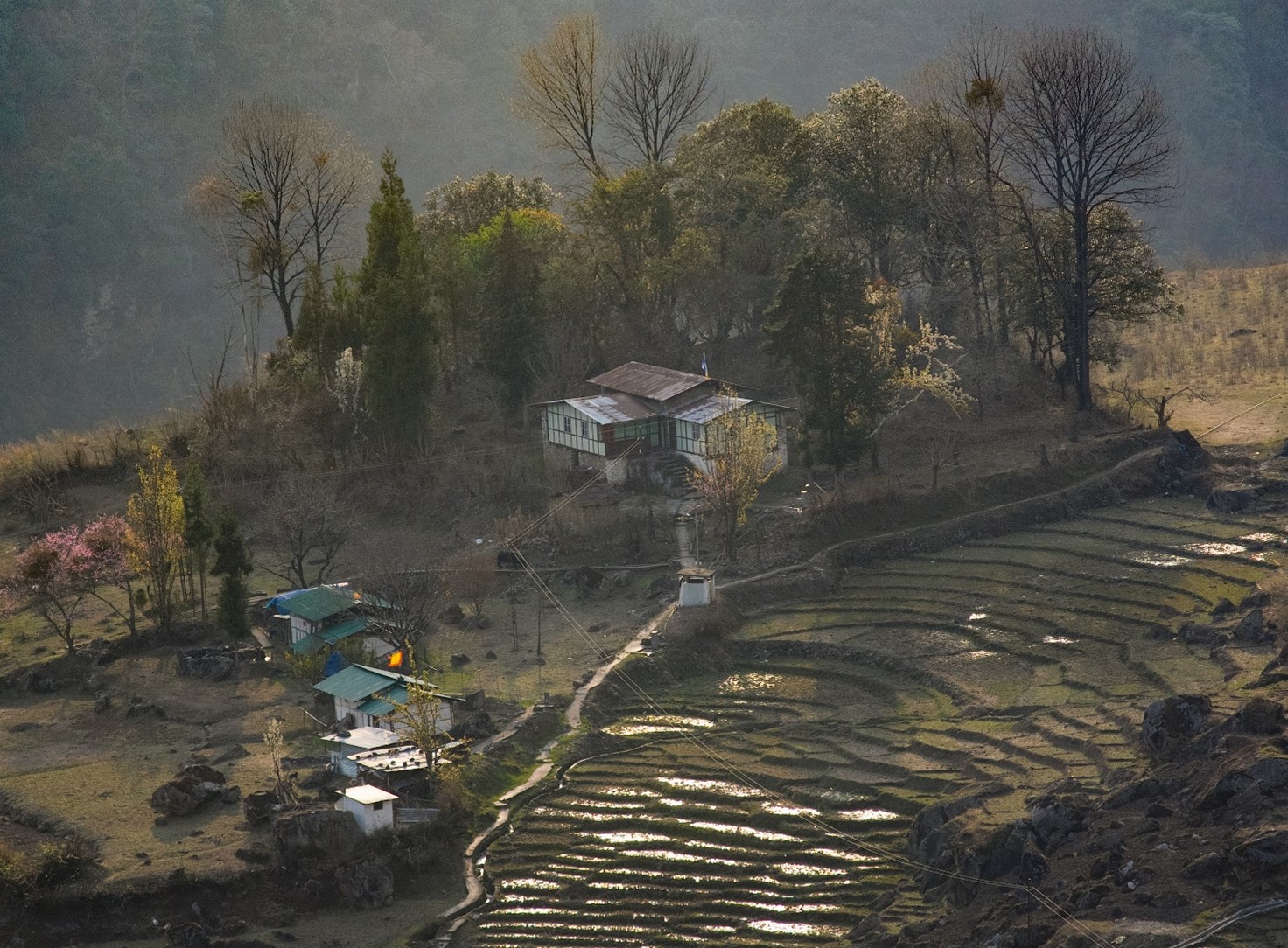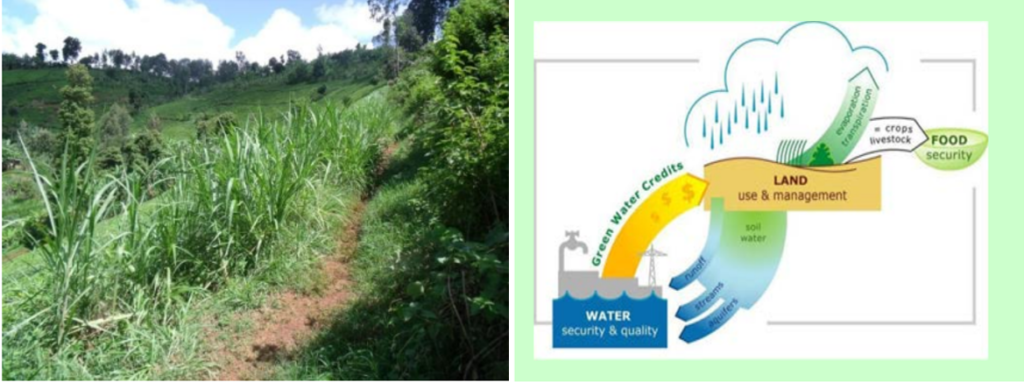Landscape approaches, and integrated watershed management

This post is also available in:
This post is also available in:
![]() Français (French)
Français (French) ![]() Deutsch (German)
Deutsch (German) ![]() हिन्दी (Hindi)
हिन्दी (Hindi) ![]() العربية (Arabic)
العربية (Arabic) ![]() Türkçe (Turkish)
Türkçe (Turkish) ![]() 简体中文 (Chinese (Simplified))
简体中文 (Chinese (Simplified)) ![]() Português (Portuguese (Brazil))
Português (Portuguese (Brazil))
Integrated watershed management and landscape approaches.
On top of steep hills, diverse forests or pastures can be needed. Also, run-off water should be managed, so fields get a steady water supply without buildings being flooded. Therefore, integrated watershed management is based on a landscape approach. (Cover Foto: From India, by Swapnil Kulkarni, India).
Collaboration is important between degraded areas upstream (where erosion and rapid water run-off start) and with areas downstream (affected by gully erosion, sedimentation and floods). Likewise, wind erosion should be prevented before sand dunes move from degraded land to valuable areas. Coordination and participation are also important for setting the right priorities in time and adjusting interventions to the local situation.
A watershed is an area supplying a river or stream with water, so coordinating conservation efforts makes good sense. Wind erosion or water flows from outside a field can erode the field. Likewise, other areas can also be damaged by erosion, floods, sedimentation, lack of groundwater replenishment from a field, bush fires, or grazing. Else, e.g., ridges and terraces can be flushed away and even concentrate erosive flows. Infrastructures like roads, rails, electricity poles, hydropower dams, channels, and low-lying buildings are badly affected in areas during the season with most problems. Still, the most cost-effective approaches will often focus on preventing risks in time and on causes of erosion before they reach expensive buildings, conserved wetlands, or political power. City planners, politicians, and engineers may get resources for costly treatment of symptoms affecting the most influential.

Figure 1. Soil and water conservation can be integrated and adapted to the landscape. E.g., at the top of the cultivated areas, excess water is often infiltrated and led off to natural or secured water way or ponds (left). Sustainable soil and water management uphill can help areas downstream, including towns, by stabilising run-off, soil water, streams, and aquifers as well as rains. In return for secure and good water supply plus reduced flood risks, green water credits can be paid to upstream areas. From Muriuki & Macharia (2011) citing Falkenmark M 1995 (right).
Integrated landscape approaches are perspectives and strategies that can help coordinate efforts, set priorities, regulate, advise, and pay upstream areas for ecosystem services benefitting areas downstream. See the Figure 1 above. The most appropriate and reliable methods may benefit all stakeholders and be locally affordable. In addition to farmers and, e.g., flood-affected people, forests, pastures, and water users should be considered – even unorganized and informal users. Likewise, innovative, practical, affordable, multipurpose solutions and “details” should not be neglected – despite the complex system approach. External funding tends to come with many conditions and be stopped. Relying only on them can be risky, e.g., if soil and water conservation structures are not maintained and people depend on them.
Furthermore, protecting one area, even temporarily, can increase the pressure on another in ways that may or may not be sustainable. Coordinated efforts are needed for protected areas early to become resilient and valuable, and alternative supplies are available.
For wind-erosion
- An integrated landscape approach has, e.g., successfully been used and evolved near Denmark’s sandy west coast over the last 150 years. Old nutrient-depleted soils were overgrazed and affected by slash and burn agriculture resulting in moving dunes like in desert-affected areas. The hardiest grasses, shrubs, and small trees were established first, and on the sandy coast, tree plantation followed then, and after that, farmland with shelterbelts (windbreaks) of medium-tall trees. Shelterbelts far from the coast became popular later than those near it.
- Other problems for plants and soils should be understood and addressed, too, so plants established can grow and survive. E.g. in Denmark, a problem of acid and hard iron-enriched subsoils (Podzol soil type) was solved, as well as both fertilizers and rotation with soil-improving fodder crops, including suitable legumes. Even for hardy trees, fertilizers (or manure) made them grow much faster, but it was realized late. Shifting cultivation and grazing were regulated.
- The windbreaks diversified to include more species and multirow shelterbelts when monoculture of an introduced species proved vulnerable and not ideal for biodiversity and sale of hunting rights.
- Tree establishment could be cheaper. Despite much government support for modern nurseries, informed farmers can often save much by seeding trees on their farms and transplanting if needed in suitable weather and good follow-up.
The shelterbelts and plantations had several benefits. They reduced wind speeds and, therefore, the need for water. Additionally, they gave biomass for fuel and hunting options. The approach has been used in many parts of the world. A challenge can be the cost of seedlings to farmers and/or governments supporting it. Still, an improved low-cost establishment can be tested and promoted, including direct seeding and local transplanting of seedlings with, e.g., moist bare roots and, if needed, tops trimmed or temporarily tied to reduce water demand before roots are fully established. Adhering soil may remain or be flushed off rather than shaken off, damaging fine active roots.
For soil and water conservation:
- The summit of hills or high mountains often has overgrazed and eroded pastures needing management. Rotational grazing and/or reduction of livestock numbers can allow good fodder plants and trees to establish at sites protected by fencing – or agreements if herders respect them at least in normal-rainfall years. Establishing valuable species, e.g., by improved direct seeding or plants with moist bare roots, can help to make protected periods short and give earlier benefits, so they become acceptable and respected. Likewise, access to fodder or wood should not be too far away either. Nitrogen-fixing plants can be seeded with improved low-cost methods, see below, to improve soil fertility, conservation fodder quality, etc., and they may need access to the right nitrogen-fixing bacteria and other nutrients -often phosphate.
- Thorny plants or branches can in grazed areas protect contour lines of vegetation. Likewise, double- or multi-rowed fences can be established using a species not eaten by animals at the side needing protection. A tendency for some plants to become a weed (weediness) and/or be invasive (invasiveness) should be considered. This is particularly important for introduced species with thorns or bitter taste (unpalatable), many seeds, and/or shooting from roots. If they are eaten by animals, then control is easier. Rights and capacity to cut them back and sell charcoal and wood can help, e.g., with the highly invasive thorny tropical tree legume Prosopis juliflora, which can shoot from below ground.
- Below areas with considerable surface water run-off, cut-off drains are usually recommended (see the section on soil conservation structures). Guidelines to lead water slowly down the slope in broad grazed waterways are common. However, livestock and people may wear these down starting rill and deeper gully (ravine) erosions. Infiltrating water uphill and/or having gravity-based irrigation dams may be suitable, but in some areas, landslides can be promoted by continuous infiltration ditches loaded with tall, heavy trees. Dams bursting can be dangerous too for people downslope. Dams tend to be filled with silt and other sediments in eroded areas, but water can still be pumped or tapped from them. Mosquito breeding can be a big problem with temporary ponds without fish and where frogs have no slope to move up and down. Fishponds can be successful but are often abandoned due to feed and fingerling supply and management skills. One tropical tree legume, Calliandra calothyrsus, can give protein-rich feed also to fish while conserving soil in contour hedges. It is mentioned in several sections by this author. Water infiltration can benefit a steady water supply for wells, deep-rooted plants, streams, and other water bodies and wetlands below. More trees upslope may reduce the annual water flow down-slope but may increase it in the drier parts of the years and reduce pollution and sedimentation (siltation) and harmful flash floods. Low-contour hedges with good surface cover will benefit much more than tall trees without soil surface protection.
- Cultivated areas are described in other sections, but good agroforestry and fodder production can significantly reduce pressure on hilltops, steep slopes, riverbanks, wetlands, road sites, etc. Zero-grazing can require less land, feed, and greenhouse gas emissions. It also reduces the risk of infectious diseases and adds value to tree legumes.
- Local people’s interaction with uncultivated areas. However, if farmers or other locals do not benefit from wild or conserved regions, they may not protect them. Promoting the use of non-timber forest products or other sustainable uses benefitting locals may give an important motivation. Improved low-cost tree/plant establishment methods can also be essential for revegetating degraded areas within an acceptable time – particularly if the benefits are for the extended family or common good and individual efforts. E.g., for semi-nomadic people, an easy establishment method of fodder or fruit trees in clan-controlled dry season pastures near their home is of interest. Accepted regulation of access to water bodies like streams is also necessary – e.g., to protect them against livestock grazing and drinking and plants at erodible banks of a stream.
References
Baumhardt RL, and Blanco-Canqui H 2014 Soil: Conservation Practices. In: Neal Van Alfen, editor-in-chief. Encyclopedia of Agriculture and Food Systems 5, Elsevier, 153-165.
Hudson W N 1987 Soil and water conservation in semi-arid areas. Silsoe Associates Ampthill, Bedford United Kingdom. Soil Resources, Management and Conservation Service. FAO Land and Water Development Division. Food and Agriculture Organization of the United Nations Rome, 1987 https://www.fao.org/3/t0321e/t0321e00.htm
Land and Water Division 2000 Manual on Integrated Soil Management and Conservation Practices. FAO land and water bulletin Series number: 1024-6703. 214 pp. ISBN: 9251044171 https://www.fao.org/publications/card/en/c/31f117c4-13e2-5631-bf16-ebaaa10b714f
Luna et al. 2000. The role of olive trees in rainfall erosivity and runoff and sediment yield in soil beneath. Hydrology and Earth Sciences 4, 141-153. https://hess.copernicus.org/articles/4/141/2000/hess-4-141-2000.pdf
Muriuki JP, Macharia PN 2011 Green Water Credits Report K12: Inventory and Analysis of Existing Soil and Water Conservation Practices in Upper Tana, Kenya. https://www.isric.org/documents/document-type/green-water-credits-report-k12-inventory-and-analysis-existing-soil-and Open access.
Mandal T. 2010. Low-cost soil and water conservation with many early benefits. Presentation Researchers’ Day: Climate Change Impact, Adaptation and Mitigation GEUS, Inst. of Geography, University of Copenhagen. 7 October 2010. Arranged by the Climate Change Task Force. https://www.yumpu.com/en/document/view/35209735/present-danish-water-forum
Thomas DB et al. 1997. Soil and water conservation manual. Soil and Water Conservation Branch, Min. Agric. Livestock Dev. and Marketing, Nairobi Kenya.
Watene G and others 2021 Water Erosion Risk Assessment in the Kenya Great Rift Valley Region Sustainability 2021, 13(2), 844; https://doi.org/10.3390/su13020844
Yoshinori et al. 2018 Factors influencing the erosivity indices of raindrops in Japanese cypress plantations. Catena 171, 54-61, December 2018, DOI:10.1016/j.catena.2018.06.030 +http://www.ffpri.affrc.go.jp/ffpri/en/research/results/2018/20180910-06.html








































































